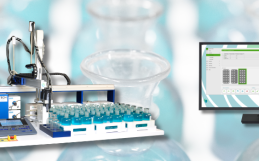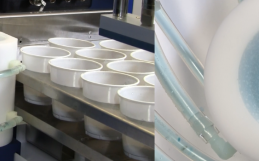For calibration, the PeCOD® Analyzer goes through the following phases:
- Normalization Phase. This is where the PeCOD® Analyzer is adjusting the LED lamp output, trying to achieve a baseline of 20µA.
- Burn-In Phase (port B). This is where the pre-mix blank solution is brought into the sensor cell. It is oxidized to remove contaminants from the cell.
- Pre-Burn Phase (port B). This is where a new aliquot of pre-mix blank solution is brought into the sensor cell. This phase removed more contaminants from the cell and conditions the cell for the pre-mix blank.
- Oxidation (port B). A new aliquot of pre-mix blank is brought into the sensor cell and is oxidized. This value is used in the peCOD calculation. The area under this curve is used to calculate the ‘blank charge’, which corresponds to the C value determined by each calibration. This is the small amount of COD contributed by the electrolyte reagent, which is then subtracted from all future COD analyses to give the final COD result.
- Pre-Burn (port A). A new aliquot of pre-mix calibrant solution is brought into the sensor cell where it is oxidized. This removes contaminants from the cell and conditions the cell for the pre-mix calibrant.
- Oxidation phase (port A). A new aliquot of pre-mix calibrant if brought into the sensor cell. This value is used in the peCOD calculation. The area under the curve is used to calculate the reference charge, which is used with the blank charge to determine the relationship between charge and COD. This corresponds to the M value determined by each calibration.
For sample analysis, the PeCOD® Analyzer goes through the following phases:
- Burn-In phase (port B). The pre-mix blank solution is brought into the sensor cell and is oxidized. This removed contaminants from the cell.
- Pre-Burn phase (port A). An aliquot of sample is brought into the sensor cell and is oxidized. This removes contaminants from the cell and conditions the cell for the sample.
- Oxidation phase (port A). A new aliquot of sample is brought into the sensor cell and is oxidized. This value is used in the peCOD calculation. The area under the curve is used to calculate the charge generated by sample oxidation. The blank value will be subtracted from the sample value to determine the sample COD.
Related Posts



